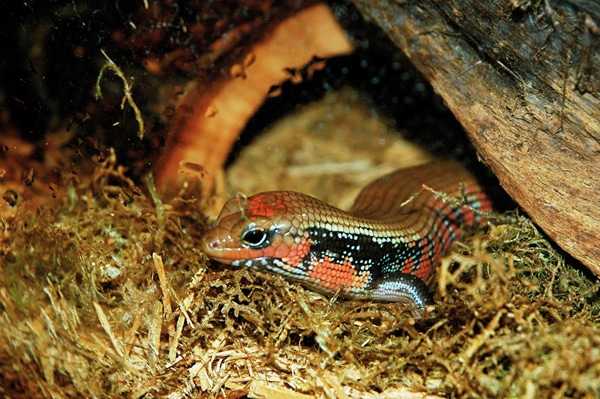A vivid red body, black and white-flecked sides and a bronze-colored back make the African fire skink (Lepidothyris fernandi) an aptly named and
A vivid red body, black and white-flecked sides and a bronze-colored back make the African fire skink (Lepidothyris fernandi) an aptly named and truly stunning lizard. However, though the fire skink has gained in popularity, some hobbyists tend to shy away from keeping it, thinking it’s a difficult species to care for. Experienced reptile keepers, on the other hand, tend to view the fire skink as being “too basic,” and perhaps even boring. In addition, the fire skink has also been mislabeled as being very skittish and a seldom-seen captive—one that prefers to stay hidden in a burrow, except when it emerges to eat.
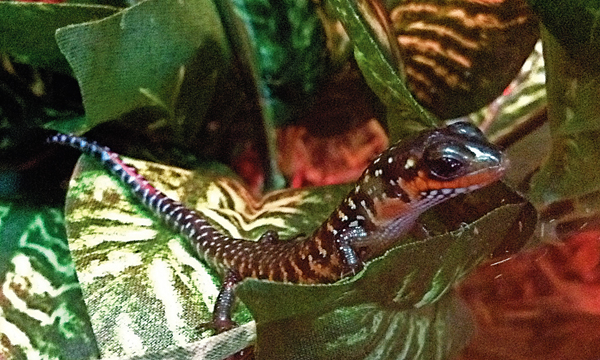
Weston Brownlee
Due to their ability to make use of any space provided, Lepidothyris fernandi do best in either a 40- or 50-gallon tank.
The fact is, when kept properly, none of these sentiments hold true. Though a fire skink may challenge its keeper to create an enclosure that will provide the required sense of security, this beautiful lizard can be a hardy and easy-to-care-for pet, rewarding hobbyists with plenty of personality in addition to its good looks.
The African fire skink was first documented in 1836. It inhabits forest and woodland habitat in West Africa, as well as scrub adjoining grasslands—areas that are abundant with hiding spots, rife with leaf litter and rich with insect life. Being opportunistic feeders, fire skinks spend the majority of their time hunting arthropods and small vertebrates. Beyond these basics facts, the fire skink is largely unstudied. Very little is known about its reproductive habits and general behaviors.
Lepidothyris fernandi is fairly large, reaching up to about 15 inches in length, including the tail. It may live 15 to 20 years in captivity. Fire skinks have been available in the reptile hobby for quite some time, and specimens do turn up at reptile expos and online. However, many of these are wild caught. Finding captive-bred fire skinks can be challenging, but it’s worthwhile to make the effort. Captive-bred fire skinks are generally healthier and don’t experience the shock and stress their wild-caught counterparts do when having to adapt to a captive environment. Because they are not as stressed, captive-bred skinks are also more visibly active in their enclosures.
Wild fire skink populations are believed to be stable, but the impact of deforestation and capture for the pet trade remains unclear. As a reptile that is largely unstudied, efforts to promote captive-breeding programs and to curb the import of wild-caught skinks are critical to keeping this beautiful lizard stable in both its habitat and the hobby.
The Ideal Fire Skink Enclosure
Key to successfully keeping a fire skink is providing a proper enclosure. Starting with the most basic requirements, fire skinks need plenty of room. Glass or acrylic tanks work well, as too much ventilation will negatively impact humidity. An adult skink can be kept in a 20-gallon long tank measuring 30 inches long by 12 inches deep and 12 inches tall, but nothing any smaller. Because fire skinks will make use of whatever space is provided, a 40- to 50-gallon tank would be much preferred.
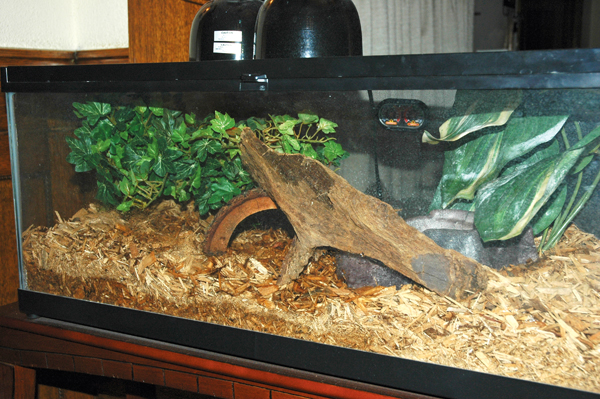
Weston brownlee
A properly prepared enclosure is vitally important to maintaining fire skinks successfully.
Fire skinks can be housed together if there is sufficient space and if the pairing is male to female. There are always exceptions and anyone desiring to keep a pair should carefully monitor the skinks, especially during breeding season, to make sure they are both eating well and that there is no fighting.
Read More
Horizontal space is more important to fire skinks than vertical, although these lizards are good at climbing, and branches placed vertically in their enclosure can add to their sense of security. Any fire skink enclosure should be naturalistic, as natural elements inside their enclosure play a pivotal role in the daily behavior of the animal, as well as its general health. A secure fire skink will display a calm disposition and will tolerate handling. They are very fast, though, so handling should be done carefully.
Substrate is the literal foundation of a good fire skink enclosure, and because these lizards are burrowers, their enclosure needs between 4 and 6 inches of substrate. Humidity retention is the most important factor when selecting a substrate type, as it should always be moist, but never soggy; relative humidity should sit between 60 and 70 percent when properly misted. Substrates such as cypress mulch work well, but require more frequent misting, and because fire skinks can be voracious eaters, coconut husk, although it provides good humidity retention, can create a risk of ingestion and impactions or stomach problems. Never use sand for a fire skink enclosure.
Every substrate choice has its pros and cons, and in the end a mixture is best. Combining nutrient-free soil and sphagnum moss offers great humidity retention. Health risks do not usually occur unless the substrate is not kept moist enough, so mist thoroughly once or twice a day. Leaf litter or moss placed on top of the substrate can help with humidity retention and create additional hiding places.
Equally important to providing a proper subterranean environment for your skink is what will go on top of the substrate. Many new keepers mistakenly believe a simple hide is enough, which has led to the misconception that fire skinks remain burrowed for most of their lives. The larger the enclosure, and the more décor it contains, the more comfortable and active your skink will be and the more it will be seen. In addition to a good hide, which can be a simple rounded log or any of the commercially available naturalistic hides available at pet stores, provide branches and plants.
Designing an enclosure similar to the fire skink’s natural habitat is not hard, and because this lizard does not feel secure in open space, artificial broad-leafed plants, shrubby bushes and other items should be used to create an enclosure that is interesting to look at and one in which the skink will be most active. Except in the case of very large enclosures, avoid live plants. They can be difficult to maintain, even if potted. Fire skinks are veritable bulldozers, and live plants will die unless they are large and well established with very secure root systems.
Fire Skink Humidity and Lighting
Proper humidity is critical for shedding and hydration, and substrate humidity is most important. Fire skinks do not require high surface humidity as long as the humidity in the substrate is in the previously mentioned 60- to 70-percent range. If this is provided, surface-level humidity can be as low as 40 percent without causing any problems.
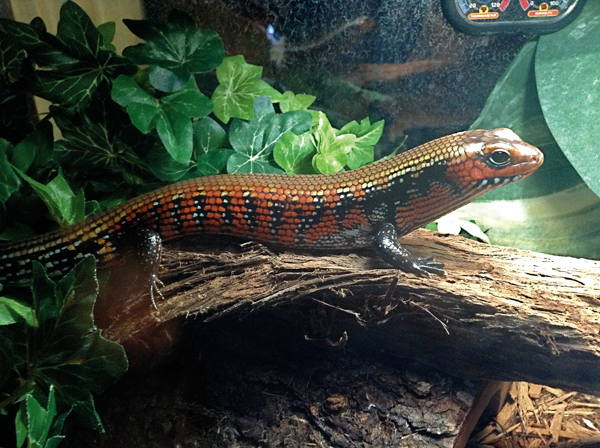
weston brownlee
The fire skink is an energetic and personable lizard when kept in an environment that promotes its sense of security.
Fire skinks need fairly high daytime temperatures, and establishing a horizontal gradient with three temperature zones is essential. The hot spot, or basking area, should be at one end of the enclosure and range from 92 to 96 degrees Fahrenheit. Fire skinks do not bask often, but sometimes will after feeding. The cool end of the enclosure can fall as low as 75 degrees as long as the ambient temperature between it and the hot spot remains between 84 and 86 degrees. As long as they are provided with a good gradient of temperatures both above and below ground, pet fire skinks will do well. Night temperatures are best maintained between 70 and 75 degrees, but can fall as low as 65.
Dome lights placed on top of the enclosure work very well as heat sources; 40- to 60-watt bulbs are usually sufficient to achieve the proper gradient. Side-mounting heaters are another option, and at least one under-tank heater should be provided. Never use any type of heat source inside the enclosure itself. Be sure to use thermometers to monitor temperatures; a hygrometer can be used to measure humidity.
The lighting needs of fire skinks are still debatable. At the very least, they benefit from and require at least some UVA exposure. A simple 40-watt day bulb can provide this. The benefits of UVB to fire skinks are inconclusive, but likely do exist. Fire skinks can thrive without UVB as long as they are receiving food dusted with calcium, but providing some exposure wouldn’t hurt.
During spring and summer, a 10- to 12-hour photoperiod is required; drop it to eight to 10 hours during the cooler months.
Fire Skink Misconceptions
Fire skinks are not widely kept and several misconceptions regarding them sometimes result in frantic online forum posts when in reality there is no call for alarm. Let’s examine the two most common misconceptions.
New keepers frequently panic the first time a fire skink nears a shed, when its vivid red coloration goes completely dull, coupled with the fire skink’s common behavior of disappearing into its substrate at this time, not surfacing even for food. This behavior is totally normal. It will usually reemerge within a day, its fiery color bright once more. So rest easy, people—the skinks are shedding, not dying.
Most would-be breeders regard fire skinks as nearly impossible to breed, yet successful breeders do not report any special requirements that are needed to promote breeding. Fire skinks that do breed seem to do so readily. Because they are notoriously difficult to sex, the most likely explanation for failed breeding attempts is that two males or two females are in fact being kept together, and obviously will never breed.
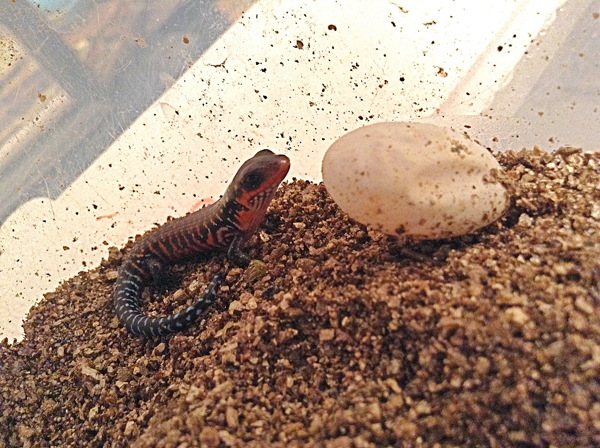
weston brownlee
A newly hatched African fire skink.
Males and females display very subtle sexual dimorphism, and generally a trained eye is the only one able to spot the differences. Males usually display slightly bulkier bodies and have a flatter, wider head and jaws. Females are usually more slender, though wider at the hips, with shorter, rounder snouts.
Though sexing fire skinks is incredibly difficult, never probe them. They can be highly strung, with a tendency to flee under duress, and the likelihood of injuring a fire skink during probing is high.
What To Feed Fire Skinks
A healthy fire skink has an appetite that borders on ravenous, with an enthusiasm for food that can result in skinks pouncing upon and even leaping after their prey. There is very little a hungry fire skink will refuse.
Fire skinks need a varied diet, so establish a suitable staple prey item and then augment your skink’s diet with supplemental feeders on a regular basis. Crickets or dubia roaches make an excellent and simple staple. Dust the staple with calcium every third feeding. Mealworms, butterworms, silkworms and waxworms are all good supplemental feeders. Waxworms are higher in fat and should be offered less frequently, more as a treat. Small pinkie mice can also be offered as an occasional treat, no more than once a month; though these are high in fat, they offer excellent nutritional value, and gravid female skinks especially will benefit greatly from them.
Establish a feeding schedule and stick to it. In general, feeding a fire skink five to six insects every three days is sufficient. A well-fed skink should look full bodied, but not overly plump. Fire skinks eat more frequently during the summer—though they will consume a great deal after emerging from winter, too, as will a gravid female.
Because fire skinks will eat almost anything, this does not mean they should. Plant matter and canned dog food have both been recommended for these lizards, but they do not require plant matter, unlike some skinks, and canned dog food does not fulfill any of their nutritional needs and should never be offered.
While seeing fire skinks eat is a common occurrence, seeing them drink is not. Most of their hydration needs are met through feeding and passively through the humidity of their environment. Nevertheless, provide a shallow water dish. This can help maintain humidity, and once in a while you may see your skink sitting in it. They may occasionally lick water off cage décor, including artificial plant leaves, or the walls of their enclosure.
The fire skink is an energetic and personable lizard when kept in an environment that promotes its sense of security. Hardy and visually stunning, it is a rare combination of exotic and easy that makes it an ideal choice for an enthusiast of any experience level. Continuing to promote their success in the hobby currently requires a greater awareness and understanding of what makes them thrive in captivity. Real knowledge is still being driven by experienced keepers who are documenting their success and taking an outspoken stance to help others in securing Fire skinks’ place within the hobby. Those currently keeping them have the rare chance to contribute to a growing body of knowledge about this amazing animal.
Weston Brownlee is a professional bronze sculptor who has worked with reptiles for years, including keeping and breeding fire skinks for the last four. He can be contacted at weston.brownlee@gmail.com.

